
You might have to squint to spot it, but yes, this is Rösti in a Waitrose Café. It’s a potato-based breakfast dish, considered to be one of Switzerland’s national dishes, and as the flagship item on Waitrose’s limited-time festive menu (£7.00), it made an ideal Tribudishional subject.
Rösti itself has quite a simple composition: par-boiled (or sometimes raw) potato is grated, then mixed with butter and pressed into an oiled frying pan. It forms a kind of fritter, which is then fried and flipped until golden on both sides. Similar in form to a Jewish Latke or an American hash brown, Rösti is delicious but subtle to eat on its own; the sharp texture contrast between the crispy skin and soft interior is by far its stand-out feature, and its gentle flavour is predominantly, well, that of potato.
Rösti’s power however, lies in its ability to pair well with almost anything. It can often be found topped with sunny-side-up fried eggs, or accompanied by various meats, such as veal or bacon. My rösti actually came as two separate patties, each with a generous rösti-to-topping ratio of ham hock, melted cheddar, cranberry sauce and sage. A poached egg was balanced precariously between them, and the whole lot was placed on a (slightly oversized) plate.

Which brings me to my first point. Perhaps it was the large expanse of empty plate that emphasised it, but to say that ‘rösti’ was one of the primary items listed in the menu description, there wasn’t all that much of it. In all fairness, the comparatively large heap of toppings may have accentuated the patties’ small size (and as aforesaid, too much potato-homogeneity can lead to a rather one-dimensional flavour profile), but still, I had hoped for a little more.
It’s actually quite fascinating how the method of food presentation can mentally trick one into feeling more sated after a meal. A good example of this is discussed in the Francesc Miralles and Hèctor García’s book Ikigai, where the Japanese practice of splitting a dinner between four or five small plates makes one feel like they have eaten a lot, when they actually haven’t. In fact, it’s a technique that’s widely used in savvy restaurants and tapas bars the world over. Serving this £7.00 rösti on a smaller plate then, might have somewhat offset its disappointing portion size.
Nevertheless, each patty undoubtedly had the classic rösti flavour; a potatoey undertone that complimented the toppings beautifully, from the sharp saltiness of the ham, to the sweet cranberry sauce. It’s clear that some thought had gone into this dish, and which elements comprised it. Which in some ways makes my issues with the texture all the more disappointing.

You see, potatoes are watery things. You’d be surprised just how much water comes out of them during cooking, and if you don’t get rid of it beforehand (through salting the potato shreds, then squeezing them in a muslin cloth – see Marcus Wareing’s Masterchef method here), all of this water can make the rösti a soggy mess. Combine that with not enough time in the pan, and you get a loosely-packed patty, lacking a crispy interior.
The fact that my rösti didn’t sport a golden-brown colour suggested the latter was true, and, regardless of whether the potato shreds had been salted and squeezed, the result was a disappointedly moist texture. Quite the opposite was true of the poached egg however, which had been cooked for a little too long, and whose yolk had all but set. Picky, I know, but notable nonetheless.

Where research into the history of foods is concerned, rösti is fairly elusive. It may be down to its simple nature, but there is a substantial lack of written recipes detailing authentic methods of preparation – odd for a national dish. It’s also difficult to date when it was first invented, so most just resort to “sometime after the discovery of the new world”, the point at which potatoes were introduced to Europe. Many credit the Canton of Bern (the region in which the Swiss capital is located) as rösti’s home, but even this is a sweeping statement. That’s a big place in a small country.
Now I must say, by far the best element of this dish was the ham hock – or wädli in Swiss. This made a delicious pairing with the rösti, its smoky, rich aroma filling every mouthful. When smothered in melting cheese (of a surprisingly decent strength) and placed on the bed of cranberry sauce, the toppings formed a sort of mini charcuterie board. Very festive indeed.
It’s just a shame then, that the rösti itself wasn’t quite up to standard. Somewhat on the small side (I can’t help but think one, larger fritter might have worked better), and lacking the crispy texture I’d hoped for, its downfalls were frustratingly rectifiable. Hopefully when Christmas next rolls around – which, let’s face it, will be in the blink of an eye – Waitrose’s rösti might have found the golden crispiness it so needs. Tribudishional Score: 5.0/10.
©The Tribudishional Food Blog / 2024
